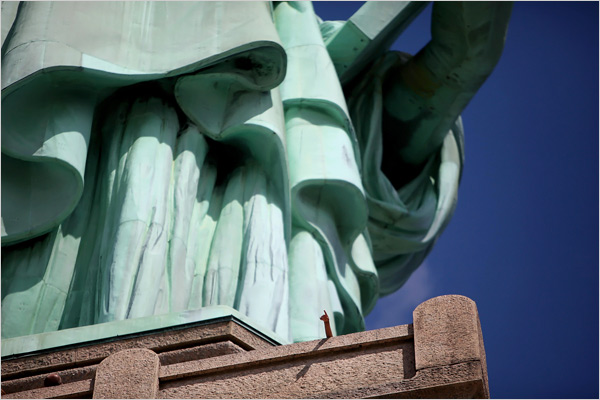The Statue of Liberty is open for business again for the first time since 9/11. As a result, New York photographers have had to deal with the task of finding a distinctive angle on one the the most familiar images in public art. This one shows the lengths we all are expected to go to see the icon anew:

A child’s arm points upward while the massive statue looms above. The photo is not likely to find its way into a photography textbook: we see nothing whole but instead only a truncated pedestal, sectioned statue, and disembodied person. You have to peer into the image to locate the child’s small arm, which then makes the statue’s bulk all the more overpowering. Distinguishing features are cut out of the picture while proportion is mangled. In its place, attention is drawn to the institutional concrete and the heavy metalwork, and to the fragility and impermanence of the child’s limb.
But the photo is not cutting anything down to size. Instead, it may be depicting a relationship between the national icon and the viewing public. Note now the child’s arm is reproduced by the arm of the statue. This is the only correspondence visible between the living person and the icon. The parallelism is likely to be symbolic: and so, just as the statue is a token of America’s past, so is the child a sign of its future. As both are aligned, and as the one is there to provide inspiration to the other, the implication is that America’s future will continue to be true to the ideals and aspirations of its past.
At this point, some would quote the text at the monument, say, about “huddled masses yearning to breathe free,” but my point is not to endorse a specific sentiment. I do want to suggest, however, that the sentimental work of the 19th century public artwork is being continued today in two registers–by the statue itself and by its photographic reproduction. Neither is innocent of complicated motives, but if you accept (as I do) that democracies depend on sentiments just as they depend on critical reason, then it is interesting to see how public arts continue to evoke such admittedly formulaic emotions. Sometimes photography simply relays another artwork and much of the time it draws on its own iconography. The image above does some of each.
An image of obvious fragmentation should also alert the viewer to its own limitations. This view of the national monument makes it seem even more, well, monumental, while reducing actual citizens to the miniaturized status of a small child who can, of course, do little more than look and point. The state may loom too large, and the people are now all but invisible individuals and certainly not masses that might be not so much huddled as unionized. But perhaps that is too much of a stretch. On the other hand, if we are to follow the lead of the photographers, we should be willing to consider more than one angle on our national icons, and on the state of the union they represent.
Photograph by Nicole Bengiveno/The New York Times.
[…] Press. (This post is the second this week on channeling 19th century public art; the first is here. Another relevant post is here.) Share and Enjoy: These icons link to social bookmarking sites […]